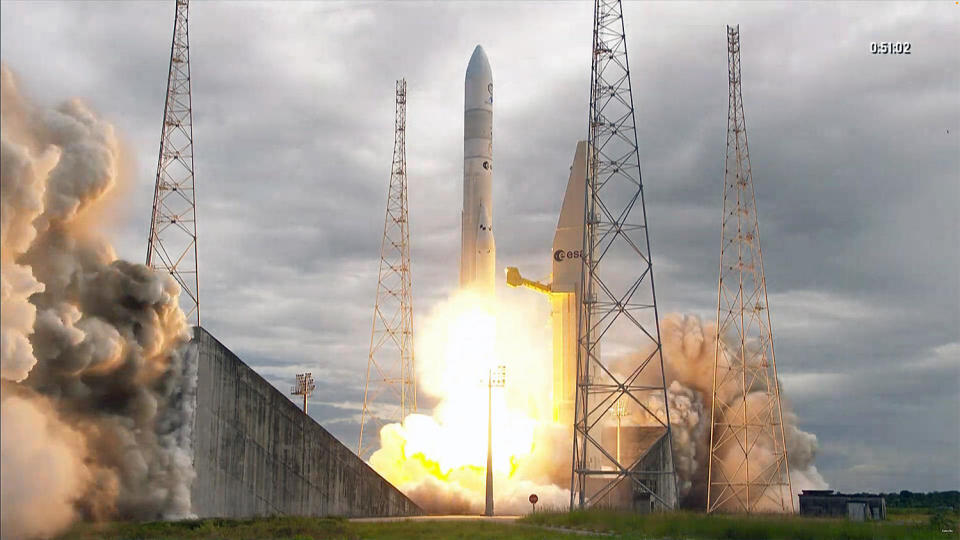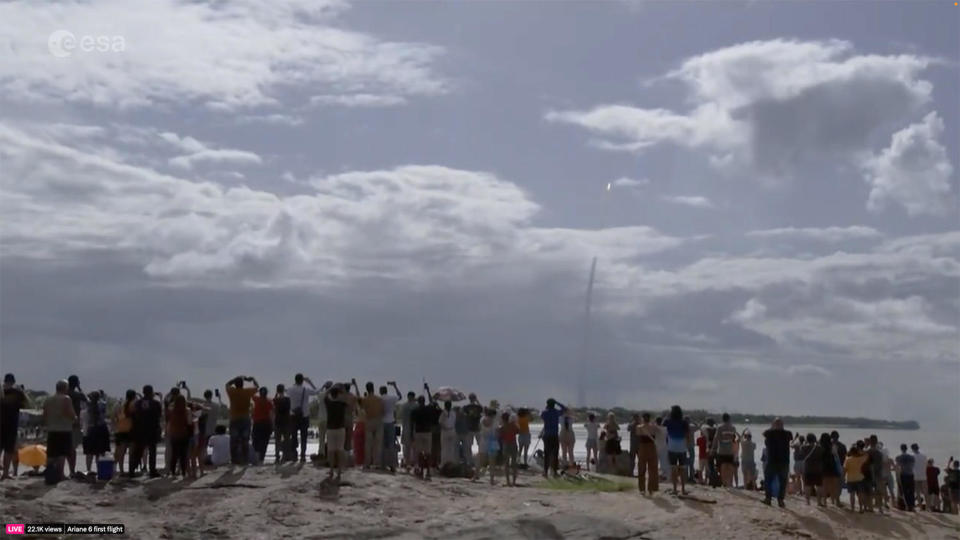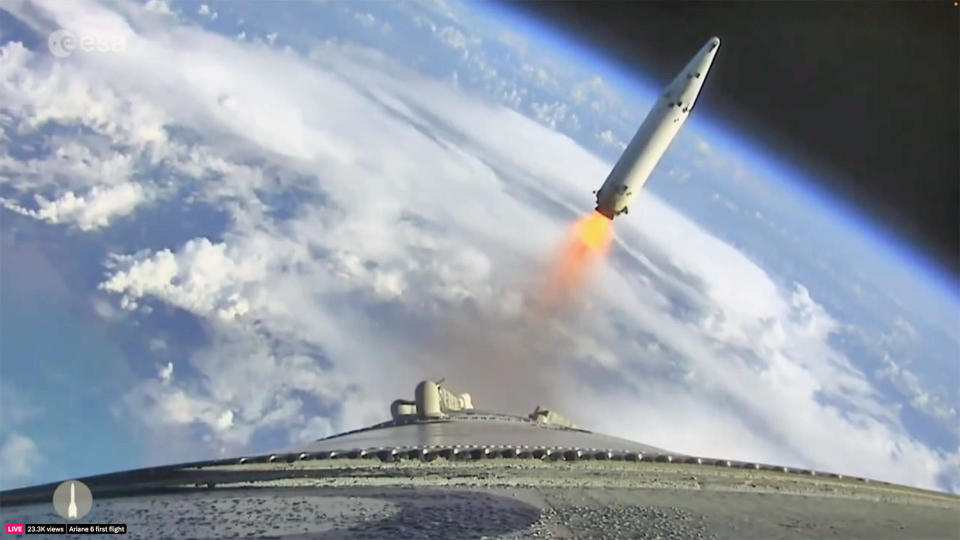Europe’s new Ariane 6 rocket has been delayed for years, but was launched for the first time on Tuesday from the European Space Agency’s launch site in French Guiana. The rocket is intended to give Europe independent access to space again.
Facing increasingly fierce international competition, European space agencies see Ariane 6 as crucial for re-establishing and maintaining their position in low Earth orbit and beyond. They can use it to launch European military satellites, scientific missions, navigation and communications satellites and other commercial payloads.

Mission managers were elated after a seemingly flawless ascent into space, marking a year without heavy launches in Europa.
“Today, Ariane is back!” said Martin Sion, CEO of ArianeGroup, the prime contractor for the rocket. “With this new launcher, Europe is restoring its autonomous access to space, and we all know how important this is for all of us.
“I want to congratulate you all, thank you,” he told flight controllers, engineers and managers in the launch control room. “I’m proud of your talent and dedication. Now we need to ramp up production to serve our customers. It’s already underway and it starts (with) our next launch before the end of the year.”
He made those comments before a problem late in the mission prevented a third upper-stage engine, intended to propel the stage back into the atmosphere, from firing as planned. That in turn delayed the deployment of two small reentry capsules designed to test innovative heat-shield technologies.
It was not immediately clear what caused the premature shutdown of a new auxiliary propulsion unit needed to keep the upper stage fuel tanks pressurized, whether the problem could result in the vehicle becoming stranded in space, and whether flight controllers would be able to fix the problem.
The long-awaited debut of Ariane 6 began when the 180-foot-tall (56-meter) rocket’s hydrogen-powered Vulcain 2.1 main engine roared to life at 3 p.m. EDT, followed by the ignition of two solid-fuel boosters, each generating 775,000 pounds (350,000 kilograms) of thrust.


The Ariane 6 rose majestically into the sky with a total thrust of 1.9 million pounds, shattering the afternoon calm at the Guiana Space Centre and putting on a spectacular, long-awaited show for government officials, industry dignitaries, launch crews and local residents.
Clearly visible through a partly cloudy sky, the two strap-on boosters burned out and fell away two minutes after liftoff. The Vulcain 2.1 main engine, which produced 308,000 pounds of thrust, continued firing for five more minutes before it too failed and the stage fell away, plummeting back into the atmosphere where it was expected to disintegrate.
The rocket’s second stage then continued its ascent into space. After two firings of the restartable, hydrogen-powered Vinci engine, the upper stage reached its planned 360-mile-high initial orbit an hour after liftoff.
For its maiden flight, Ariane 6 carried several small payloads, provided by ESA, NASA, industry, research institutes and students. Among the nine satellites deployed were two small experimental return capsules, designed to test new heat shield technologies, and two NASA “cubesats” built to study radio waves emitted by powerful solar flares.
A third and final engine burn was planned to propel the second stage back into the atmosphere for a destructive reentry, eliminating any chance of creating more space debris in low Earth orbit. But the anomaly that caused the auxiliary propulsion unit to shut down prematurely put those plans on hold.
Assuming the problem is eventually resolved, a second launch is planned for the end of the year. Six flights are booked for 2025, eight flights in 2026 and ten in 2027. After clearing the current backlog, European space operators expect to maintain a “steady state” of nine launches per year.
“What a huge step forward for @ESA as it launches its powerful next-generation rocket, carrying a @NASASun science instrument,” NASA Administrator Bill Nelson said in a message on X. “Together with our international partners, we are leading a new era of space exploration.”
To take off, #Ariane6!
What a huge leap forward for @ESA with the first launch of its powerful next-generation rocket – and with a @NASASun scientific instrument on board.
Together with our international partners, we are leading a new era of space exploration. https://t.co/5IIvCyExtE
— Bill Nelson (@SenBillNelson) July 9, 2024
The launch of Ariane 6 was a major milestone for the 13 member states of the European Space Agency (ESA), prime contractor ArianeGroup, the French space agency CNES, which built the launch pad, and Arianespace, the consortium that sells and manages Ariane flights.
The rocket’s predecessor, the venerable Ariane 5was retired last year after 117 flights, including the launch of the James Webb Space Telescope in 2021. The Ariane 6 is roughly similar to the Ariane 5, but uses improved components and is expected to cost 40% less to build and operate.
But not like SpaceXWhile the current launch market is dominated by reusable first stages and payload fairings, Ariane 6 is fully replaceable, with no parts being reclaimed. Toni Tolker-Nielsen, ESA’s Director of Space Transportation, recently told Space News that “our launch needs are so low that (reusability) would not make economic sense.”
“We don’t really need it at the moment,” he said. “But if we launch more often in the future, we need reusability for economic reasons. The second reason to have reusability for a European launch vehicle is sustainability. We need to have a circular economy in 10 or 20 years, we need to be sustainable.”


Ariane 6 was originally scheduled to launch in 2020, but a series of economic and technical obstacles delayed the first flight by four years.
Meanwhile, a joint program with the Russian space agency Roscosmos, which involved launching Soyuz rockets with a medium launch capacity from French Guiana, fell apart after The Russian invasion of UkraineTo make matters worse, Europe’s small Vega-C rocket was grounded after its second launch failed.
And so, since the last flight of Ariane 5 last July, Europe has had no rockets of its own to launch European payloads. In fact, at least four satellites originally scheduled to fly on European launchers were instead placed into orbit on SpaceX Falcon 9 rockets.
“You don’t want to be dependent on anyone and that’s why all spacefaring nations want their own access to space,” said Lucia Linares, director of the Space Transportation Strategy and Institutional Launches Division at ESA, in a speech quoted by the journal Nature.
Two variants of the Ariane 6 are planned: one with two strap-on boosters, the Ariane 62, and a more powerful version, the Ariane 64, with four strap-on boosters. Different payload fairings are available to accommodate different payload sizes.
According to Tolker-Nielsen, this “modular” system is ideal from a European perspective.
“It’s a perfect system because Ariane 62 replaces the Russian Soyuz and Ariane 64 replaces Ariane 5,” he said. “So it meets all our needs. Ariane 6 could be the European workhorse for the next 15 to 30 years.”
Sneak Peek: Murder by Clown
Easy and delicious overnight oats recipes to try this summer
Biden to speak at NATO summit marking 75th anniversary